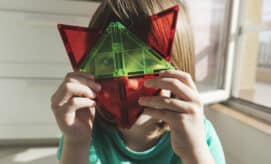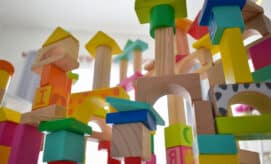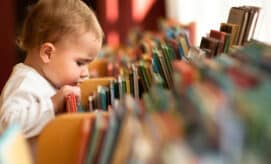Early math skills are an important part of an ECE curriculum. Knowing how to count, identify numbers and shapes, and recognize the way that numeracy fits into our everyday lives prepares children for success in kindergarten and elementary school. In this article, we share quick and fun tips designed to inspire the children in your care to be excited and curious about numbers and math.
Considering Math Feelings
Many grown-ups have mixed feelings about mathematics from their own childhood, and this can make it intimidating to introduce numeracy concepts to children. When they remember math as a struggle, educators and care providers might be less than eager to incorporate math concepts into their curriculum. It can be reassuring to keep in mind that young children are eager to learn about the world around them — and shapes, counting, categorizing, and patterns are a big part of that!
When we make math fun and relevant, we encourage young children to feel inspired to keep learning.
Unique Learning Styles & Abilities
There are many different learning styles and ways of thinking in your classroom. Some children might take to math concepts right away, while others might be less interested. Some might enter your classroom with a great deal of foundational math knowledge, while others might still be working on the basics.
This is why it is a good idea to incorporate math into your curriculum in a variety of different ways. Offering a range of approaches and activities allows children of different ability levels to practice the skills that are right for them, while encouraging them to enjoy learning new math concepts.
Quick Tips for Making Math Fun!
There are many ways to make math engaging and fun for young children! Incorporating math concepts into daily activities and familiar routines helps it to feel relevant to their daily lives. Using games or activities that children already enjoy is another great way to help spark children’s interest.
1. Counting & Pattern Games
When math feels like a game, it makes it fun and exciting for young children to play. Any game with counting, shapes, or pattern matching can help children learn basic math skills. For example, Simon Says, can be a great way for children to practice counting by encouraging children to take four steps forward or five steps backwards. Asking children to look outside for the biggest leaf they can find helps children learn about ordering and organizing by size. Another fun idea is to encourage children to see who can make the tallest block tower. Children can practice measuring to see whose is tallest, or count the different blocks to see who used the most!
2. Making Mistakes
One of the best ways to make math approachable is to use humor! While you’re counting with children, make a mistake and see if children can spot the error: “How many friends do we have at school today? One, two, three, six…? Six? Wait, is that right? What number comes after three?” Using silliness in learning about numbers makes it feel enjoyable for young children and also models what it looks like to laugh and learn from our mistakes without being too hard on ourselves!
3. Incorporating Numeracy into Daily Activities
A popular way to incorporate math into your curriculum is to slip it into activities that children already know and enjoy. For example, if you are reading a book during circle time, you might count how many clouds or trees are in a picture on a specific page.
A tip from Victoria (Mia) Almeda, an affiliate of DREME (Development and Research in Early Math Education), an organization that researches education policies and practices related to STEM learning, is to “re-read the same book. When re-reading stories, you can focus on other math concepts. You may want to discuss vocabulary words about math (e.g., more, less) or point out some patterns in the book. Repeated readings strengthen what children have previously learned and equip them to learn new math skills and concepts within the story.”
4. Graph It
Creating a visual representation of math skills can help to make concepts of counting feel more concrete. Using big poster boards, whiteboards, or large pieces of construction paper, create graphs that represent different activities and projects that you have done with the children in your classroom. For example, one day you might compare everyone’s shoes to see how many shoes have laces and how many do not. Then, create a bar graph that compares side-by-side the number of children who have laces and those who do not. You can do this with a variety of different variables, such as different colors that children are wearing, foods they enjoy, and more!
Graphing encourages exploration of a number of mathematical concepts, such as counting, sorting, organizing, and 1:1 correspondence. Children in early childhood are observant about the similarities and differences between themselves and their peers. These activities help to start a conversation about these types of observations, while also helping children to learn important academic skills.
5. Musical Math
Many young children love singing, dancing, and listening to music, which is why it can be a helpful tool for helping them to learn about math! There are many songs that involve counting and shapes, or you can even make up your own with the children in your class. Here are a few fun songs that you might enjoy sharing with the children in your care…





